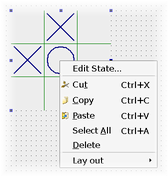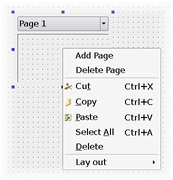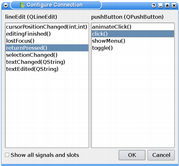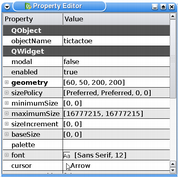Creating Custom Widget ExtensionsOnce you have a custom widget plugin for Qt Designer, you can provide it with the expected behavior and functionality within Qt Designer's workspace, using custom widget extensions. Extension TypesThere are four available types of extensions in Qt Designer. You can use all the extensions following the same pattern, only replacing the respective extension base class. QDesignerTaskMenuExtension is useful for custom widgets while QDesignerContainerExtension is necessary when implementing a custom multi-page container.
The usage of QDesignerMemberSheetExtension and QDesignerPropertySheetExtension is more rare, but the classes enables you to manipulate the appearance of class members within Qt Designer's workspace.
Qt Designer uses the QDesignerPropertySheetExtension and the QDesignerMemberSheetExtension classes to feed its property and signal and slot editors. Whenever a widget is selected in its workspace, Qt Designer will query for the widget's property sheet extension, and whenever a connection between two widgets is requested, Qt Designer will query for the widgets' member sheet extensions. Warning: All widgets have default property and member sheets. But if you implement custom property sheet or member sheet extensions, these extensions will override the default sheets. Creating an ExtensionTo create an extension you must inherit both QObject and the appropriate base class, and reimplement its functions. Since we are implementing an interface, we must ensure that it's made known to the meta object system using the Q_INTERFACES() macro in the extension class's definition. For example: class MyExtension: public QObject,
public QdesignerContainerExtension
{
Q_OBJECT
Q_INTERFACE(QDesignerContainerExtension)
...
}
This enables Qt Designer to use the qobject_cast() function to query for supported interfaces using nothing but a QObject pointer. Exposing an Extension to Qt DesignerIn Qt Designer the extensions are not created until they are required. For that reason, when implementing extensions, you must subclass QExtensionFactory to create a class that is able to make instances of your extensions. In addition you must register your factory with Qt Designer's extension manager; the extension manager controls the construction of extensions as they are required. When an extension is requested, Qt Designer's extension manager will run through all its registered factories calling QExtensionFactory::createExtension() for each until it finds one that is able to create the requested extension for the selected widget. This factory will then make an instance of the extension. 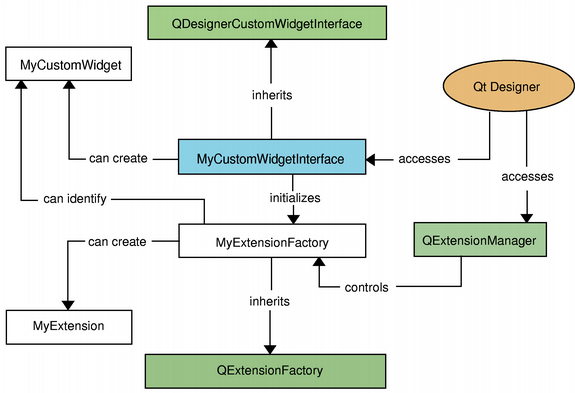 Creating an Extension FactoryThe QExtensionFactory class provides a standard extension factory, but can also be used as an interface for custom extension factories. The purpose is to reimplement the QExtensionFactory::createExtension() function, making it able to create your extension, such as a MultiPageWidget container extension. You can either create a new QExtensionFactory and reimplement the QExtensionFactory::createExtension() function: QObject *ANewExtensionFactory::createExtension(QObject *object,
const QString &iid, QObject *parent) const
{
if (iid != Q_TYPEID(QDesignerContainerExtension))
return 0;
if (MyCustomWidget *widget = qobject_cast<MyCustomWidget*>
(object))
return new MyContainerExtension(widget, parent);
return 0;
}
or you can use an existing factory, expanding the QExtensionFactory::createExtension() function to enable the factory to create your custom extension as well: QObject *AGeneralExtensionFactory::createExtension(QObject *object,
const QString &iid, QObject *parent) const
{
MyCustomWidget *widget = qobject_cast<MyCustomWidget*>(object);
if (widget && (iid == Q_TYPEID(QDesignerTaskMenuExtension))) {
return new MyTaskMenuExtension(widget, parent);
} else if (widget && (iid == Q_TYPEID(QDesignerContainerExtension))) {
return new MyContainerExtension(widget, parent);
} else {
return 0;
}
}
Accessing Qt Designer's Extension ManagerWhen implementing a custom widget plugin, you must subclass the QDesignerCustomWidgetInterface to expose your plugin to Qt Designer. This is covered in more detail in the Creating Custom Widgets for Qt Designer section. The registration of an extension factory is typically made in the QDesignerCustomWidgetInterface::initialize() function: void MyPlugin::initialize(QDesignerFormEditorInterface *formEditor)
{
if (initialized)
return;
QExtensionManager *manager = formEditor->extensionManager();
Q_ASSERT(manager != 0);
manager->registerExtensions(new MyExtensionFactory(manager),
Q_TYPEID(QDesignerTaskMenuExtension));
initialized = true;
}
The formEditor parameter in the QDesignerCustomWidgetInterface::initialize() function is a pointer to Qt Designer's current QDesignerFormEditorInterface object. You must use the QDesignerFormEditorInterface::extensionManager() function to retrieve an interface to Qt Designer's extension manager. Then you use the QExtensionManager::registerExtensions() function to register your custom extension factory. Related ExamplesPlease see the Task Menu Extension and Container Extension examples for more information about creating custom widget extensions in Qt Designer. [Previous: Creating Custom Widgets for Qt Designer] [Contents] [Next: Qt Designer's UI File Format] |
Publicité
Best OfActualités les plus luesSemaine
Mois
Année


Le Qt Developer Network au hasard
Comment fermer une applicationLe Qt Developer Network est un réseau de développeurs Qt anglophone, où ils peuvent partager leur expérience sur le framework. Lire l'article.
CommunautéRessources
Liens utilesContact
Qt dans le magazine |
| Cette page est une traduction d'une page de la documentation de Qt, écrite par Nokia Corporation and/or its subsidiary(-ies). Les éventuels problèmes résultant d'une mauvaise traduction ne sont pas imputables à Nokia. | Qt 4.2 | |
| Copyright © 2012 Developpez LLC. Tous droits réservés Developpez LLC. Aucune reproduction, même partielle, ne peut être faite de ce site et de l'ensemble de son contenu : textes, documents et images sans l'autorisation expresse de Developpez LLC. Sinon, vous encourez selon la loi jusqu'à 3 ans de prison et jusqu'à 300 000 E de dommages et intérêts. Cette page est déposée à la SACD. | ||
| Vous avez déniché une erreur ? Un bug ? Une redirection cassée ? Ou tout autre problème, quel qu'il soit ? Ou bien vous désirez participer à ce projet de traduction ? N'hésitez pas à nous contacter ou par MP ! | ||
Copyright © 2000-2012 - www.developpez.com




















